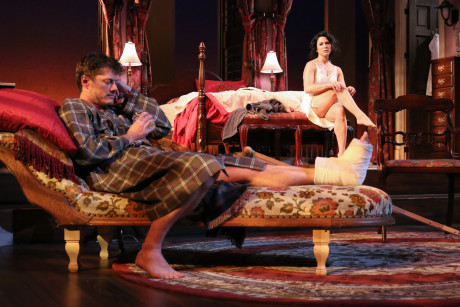Southern jazz fills the theatre as the warm lights come up on a bedroom. A mix of yellow and pink shines through the windows at the back of the stage, transporting us to sunset on a hot, summer evening. The lights emphasize the reds and oranges of the elegant, southern-style furniture, and a slow drumming ensues, creating the foreboding rhythm for what we were about to see as the sound slowly faded, and Act One begins.

Written by Tennessee Williams and directed by Mitchell Hébert, Cat on a Hot Tin Roof is comprised of three acts. The story follows Brick (Gregory Woodell) as he tries to find ta sense of personal happiness amidst his alcoholism, ankle injury, and unhappy marriage to Maggie (Alyssa Wilmoth Keegan). Taking place in his family home in Mississippi, we are introduced to Big Momma (Sarah Marshall) and Big Daddy (Rick Foucheux), as well as his brother (Todd Scofield) and his own family as everyone gathers to celebrate Big Daddy’s 65th birthday. With so many people trapped under one roof, tension builds, hidden truths come out, and any semblance of order starts to unravel.
Dramaturg Brent Stansell explains in his program notes that the play is often described as a musical, with “the first act as an aria for Maggie, the second act as a dynamic duet between Big Daddy and Brick, and the third act as a symphony of the entire Pollitt family.” Brilliantly conceived by Hébert, he and his design team cleverly utilized this concept to create a striking experience for the eyes and ears.
Sound Designer Christopher Baine and Lighting Designer Andrew R. Cissna successfully transported us to a Mississippi plantation. I could almost feel the heat through the coloring of Cissna’s creation, and Baine created a soundtrack that emphasized the setting, while at the same time highlighting the tension and drama that would come through the deep jazz mixed with the slow, steady beat of a drum. However, Cissna’s work did not stop there. His design successfully played off of Scenic Designer Meghan Raham’s lovely color scheme, with red, southern style furniture and a chandelier that hung from the ceiling.
Finally, Costume Designer Ivania Stack’s gorgeous design clearly distinguished each family member based on his or her personality. For example, stylish and classy Maggie’s sleek black dress sharply contrasted with the design for Mae (Marni Penning). As the uptight mom of three, she wore a bright green number with a large pink bow, which helped emphasize the hilarity of her scenes and her over-the-top nature.
Of course, it is impossible to discuss a Tenessee Williams play without drawing attention to the script. It is said that this was Williams’ favorite of his plays, and I can’t say I’m surprised. As always, he includes a sharp wit that adds a much-needed humor to the most dramatic of situations. However, in this particular play, the funnier elements created a fascinating contrast to the darker moments, especially in the first scene between Maggie and Brick.
There is a stereotype that suggests a social mask in the south – a tendency to hide anything unpleasant behind a façade of light humor good hospitality. As the unfortunate secrets of Maggie and Brick’s marriage rose to the surface, the comedy reminded me of that mask, and though I was laughing along with the rest of the audience, it made me feel for the couple even more. The harsher the jokes, the harder they were trying to cover the pain. Williams’ script utilized these moments throughout, and made for an entertaining and dramatic script that kept me hooked from start to finish.
Williams’ fast-paced and emotional script cannot be easy for anyone to master, but these actors rose to the challenge. As an ensemble, the group carried kept me invested from moment to moment, particularly with the honesty they infused into the relationships. I could believe the sibling rivalry between Gooper (Todd Scofield) and Brick, and the jealousy between Maggie towards Mae for living the life of motherhood that she desires.

Marshall’s portrayal of Big Mamma was absolutely hilarious. Her nosey and loving nature made her impossible not to love, and I was always eager to see more of her on stage. Foucheux’s approach to Big Daddy was an exact opposite. While Marshall created a larger than life character, Foucheaux was subtle, and the contrast made for a fascinating marriage to watch unfold.
The relationship between Foucheux and Brick was equally as interesting, and made Act Two one of the more dramatically thrilling portions of the play. As Foucheux pushed Brick to reveal the secrets behind his depression, I could almost feel the tension of this father and son relationship, as well as the true desperation of Foucheux to help a loved one in whatever way he could.
The relationship that stole the show was that of Maggie and Brick. Keegan and Wooddell played off each other beautifully, and the stage chemistry was spot-on. Though their marriage had difficulties, the two characters also stood by each other, and all I wanted was to see them find a sense of happiness and succeed.
Visually striking and emotionally thrilling, Round House Theatre’s sizzlin’ Cat on a Hot Tin Roof simply should not be missed.
Running Time: Two hours and 40 minutes, with two intermissions.
Cat on a Hot Tin Roof plays through April 24, 2016 at Round House Theatre – 4545 East-West Highway, in Bethesda, MD. For tickets, call the box office at (240) 644-1100, or purchase them online.
RATING:





